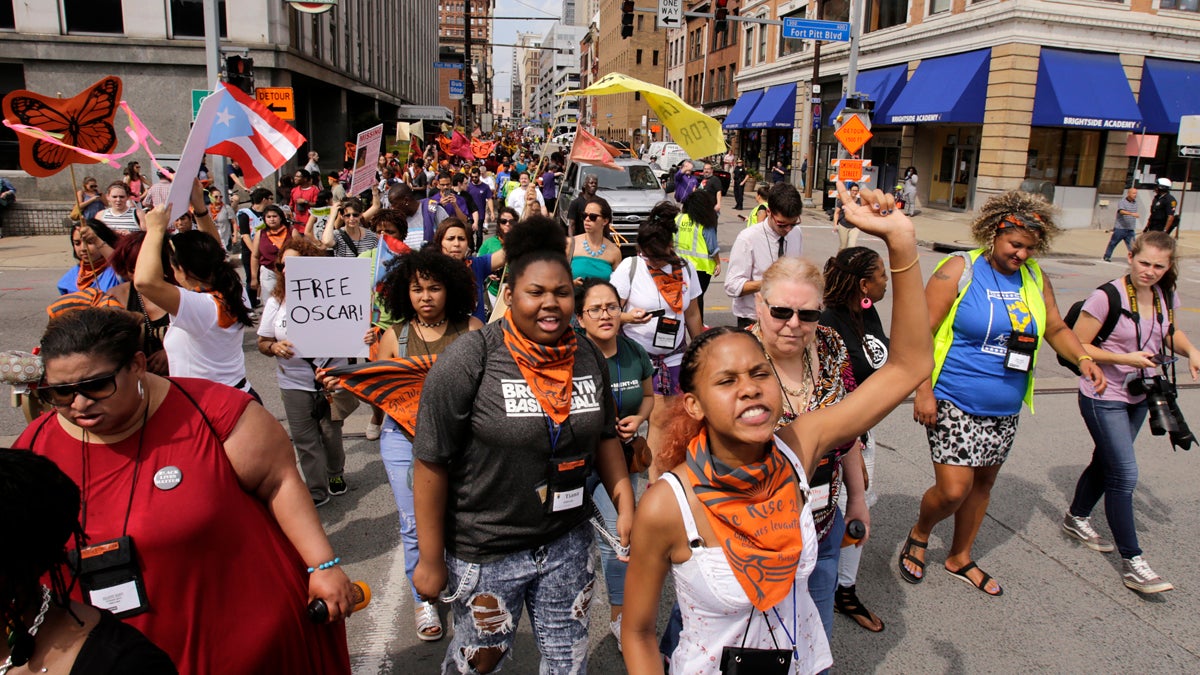Making Pa.’s police forces reflect the communities they serve

Marchers from 40 progressive groups from 30 states take part in the “Still We Rise” March in downtown Pittsburgh Friday
City police departments are working on diversity.
Last week was rough. In separate incidents, young black men were shot and killed by police officers in Baton Rouge, LA and St. Paul, MN. Then, at a protest over those shooting deaths, a gunman killed five police officers in Dallas, TX.
These events have reignited the national conversation about race and policing. As Pittsburgh Police Chief Cameron McLay told NPR’s Morning Edition on Monday, “This isn’t a new narrative, nor is it a new tension. I mean, it’s something that really has shaped law enforcement since, really since Ferguson.”
Demographic mismatch
Let’s look at McLay’s department. More than a quarter of Pittsburgh’s residents are black. According to a 2014 annual report, the police department is 13 percent black, but that number is on the ascent.
A 2012 lawsuit by the ACLU alleged discriminatory hiring practices — excluding black candidates — at the Pittsburgh Police Department. Between 2001 and 2012, the lawsuit stated, PPD hired 368 officers, only 14 of whom were black.
To settle the lawsuit, the department promised a three-year overhaul of hiring practices. According to the Pittsburgh Post-Gazette, the city has spent $250,000 on consultants, updated the job requirements and codified the applicant review process.
There are positive signs that these efforts are working. The March 2016 recruit class was not only the largest class since the 1990s, but among the most diverse: 18 percent of the 62 new recruits are racial minorities. In the August 2015 class, nearly 30 percent of the recruits were minorities.
Other departments around the state are trying to emulate those diverse hiring practices, minus the lawsuit. According to GoErie, Erie has only five black officers and two Hispanic officers, out of a force of 173. That doesn’t reflect the city, which is 17 percent black and 7 percent Hispanic. The Erie Police Department has sent the minority officers it does have into the community to recruit others who might be interested.
Even Adams County, which is majority white, is concerned. The Evening Sun found that while 9.4 percent of Adams County residents are non-white, only 3.6 percent of police officers serving the county are. Smaller police departments, like Gettysburg and Cumberland Township, are working to hire even one minority officer.
With limited budgets for recruiting and hiring new officers, many of these small departments have good intentions — and not much else to work with when it comes to diversifying their force.
Addressing structural issues
If it was 1970, the Allentown Police Department would be considered more diverse than the community it serves. Back then, the city was 98 percent white. But today, Allentown is 42 percent Hispanic and 13 percent black. The police department hasn’t quite kept pace, at 9 percent Hispanic and 3 percent black.
But when Chief Keith Morris took the top job eight months ago, he decided to make diversity a priority. Of the 18 officers he has hired, 40 percent are non-white.
But he has run into some structural problems that prohibit the hiring of more diverse candidates, namely civil service test rules.
“Those civil service rules lay out some automatic disqualifiers,” said Morris. “So what I’ve done is asked several minority community members to take a look at our civil service rules and see if there are any potential roadblocks for the hiring of minorities.”
A marijuana possession charge, for example, is an automatic disqualifier, one that Morris thinks the group may suggest doing away with.
Tyrone Russell, the coordinator for racial and ethnic justice at the Community Action Committee of the Lehigh Valley, is part of the committee that’s examining the rules.
“To see that the police department has more minority candidates, more people who look like them, that builds trust,” said Russell. “But it also helps the officers, if they have partners who are minorities, it helps them to relate to the communities they serve better.”
This is, according to Morris, the first time the department has asked for community input into hiring practices.
The Allentown Police Department, before Morris came on as chief, had a spate of lawsuits concerning use-of-force. Morris says “every department will have lawsuits,” but APD faced eight in one year, according to the Morning Call. Not all of the alleged victims were black or Hispanic.
“There are obviously a lot of big issues that police departments face,” said Morris. “But diversity is one that we have failed at for a long time, and we are trying to take big strides with that. We hold our officers to the highest standards, and, as part of that, we need to be able to connect to and reflect the community.”
Morris and a number of officers joined a demonstration in front of City Hall Monday night, calling for solidarity and peace after the recent national events. The diversity committee meets for the first time Wednesday night.
Russell, for one, thinks the timing couldn’t be better.
“I think the relationship in the community [with the police] is solid and sound,” he said. “But I think a lot of places probably thought their relationships were solid and sound until something happened. We want to ask now, how can we all be better?”
WHYY is your source for fact-based, in-depth journalism and information. As a nonprofit organization, we rely on financial support from readers like you. Please give today.


